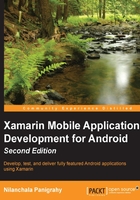
The Android bindings design
The core parts of Xamarin.Android are the bindings for the Android APIs. The Xamarin team focused a great deal in developing a consistent approach to create the bindings so that a C# .NET developer would feel at home when using them. This has resulted in a number of key benefits as follows:
- The Android API feels natural to a C# .NET developer and allows the developer to explore the API using the code completion and pop-up documentation from within the IDE
- C# developers can leverage the vast array of Java/Android examples and documentation that can be easily transformed for use with C# and Xamarin.Android
Design principles
The following are some of the key design principles for the Xamarin.Android binding. A complete set of design principles can be found on the Xamarin website:
- Allowing developers to subclass Java classes from the Android application framework
- Exposing a strongly typed API
- Exposing JavaBean properties as C# properties
- Exposing Java event listeners as C# delegates
C# properties
The JavaBean properties, the getter and setter methods, are transformed to C# properties, when appropriate. The following rules are used to determine when properties should be created:
- Read/write properties are created for the getter and setter method pairs
- Read-only properties are created for getters without corresponding setter methods
- No write-only properties are created in the rare case that only a setter exists
- Properties are not created when the type would be an array
Delegates
The Android APIs follow the Java pattern for defining and hooking up event listeners. The C# developers are more familiar with using delegates and events, so the Android bindings attempt to facilitate this using the following rules:
- When a
listenercallback has avoidreturn, an event is generated based on theEventHandlerdelegate - When a
listenercallback does not have avoidreturn, a specific delegate is generated that supports the appropriate signature
These events or properties are only created under the following conditions:
- The Android event handling method has a prefix, for example,
setOnClickListener - The Android event handler has a
voidreturn type - The Android event handler has a single parameter
Constants to enumerations
It is common in the Android APIs to see methods that accept or return an int type that must be mapped to a constant to determine its meaning. When possible, the Xamarin team creates a .NET enumeration to replace the constants and adjusts the appropriate methods to work with the enumerations. This provides a significant productivity gain by being able to use IntelliSense from within the IDE as well as enhance the type safety of the methods.